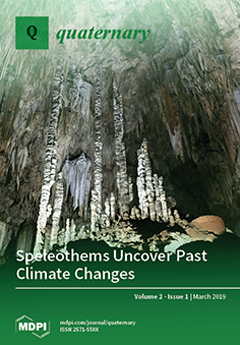In this article, I show how an Ultisol, representative of a globally-important group of soils with clay-rich subsoils, low base saturation, and low fertility, in the central Waikato region in northern North Island, can be evaluated using soil stratigraphy and tephrochronology to answer
[...] Read more.
In this article, I show how an Ultisol, representative of a globally-important group of soils with clay-rich subsoils, low base saturation, and low fertility, in the central Waikato region in northern North Island, can be evaluated using soil stratigraphy and tephrochronology to answer challenging questions about its genesis, age and classification. The Kainui soil, a Typic Kandiudult (
Soil Taxonomy) and Buried-granular Yellow Ultic Soil (
New Zealand Soil Classification), occurs on low rolling hills of Mid-Quaternary age mainly in the Hamilton lowlands in, and north and northeast of, Hamilton city. It is a composite, multi-layered tephra-derived soil consisting of two distinct parts, upper and lower. The
upper part is a coverbed typically c. 0.4–0.7 m in thickness (c. 0.6 m on average) comprising numerous late Quaternary rhyolitic and andesitic tephras that have been accumulating incrementally since c. 50 ka (the age of Rotoehu Ash at the coverbed’s base) whilst simultaneously being pedogenically altered (i.e., forming soil horizons) via developmental upbuilding pedogenesis during Marine Oxygen Isotope Stages (MOIS) 3-1. Any original depositional (fall) bedding has been almost entirely masked by pedogenic alteration. Sediments in lakes aged c. 20 ka adjacent to the low hills have preserved around 40 separate, thin, macroscopic tephra-fall beds mainly rhyolitic in composition, and equivalent subaerial deposits together form the upper c. 30 cm of the coverbed. Okareka (c. 21.8 ka), Okaia (c. 28.6 ka), Tāhuna (c. 39.3 ka) and (especially) Rotoehu tephras make up the bulk of the lower c. 30 cm of the coverbed. Tephra admixing has occurred throughout the coverbed because of soil upbuilding processes. Moderately well drained, this upper profile is dominated by halloysite (not allophane) in the clay fraction because of limited desilication. In contrast, Otorohanga soils, on rolling hills to the south of Hamilton, are formed in equivalent but thicker (>c. 0.8 m) late Quaternary tephras ≤c. 50 ka that are somewhat more andesitic although predominantly rhyolitic overall. These deeper soils are well drained with strong desilication and thus are allophanic, generating Typic Hapludands. Ubiquitous redox features, together with short-lived contemporary reduction observed in the lower coverbed of a Kainui soil profile, indicate that the Kainui soil in general is likely to be saturated by perching for several days, or near saturation for several months, each year. The perching occurs because the coverbed overlies a slowly-permeable, buried, clay-rich paleosol on upper Hamilton Ash beds, >c. 50 ka in age, which makes up the
lower part of the two-storeyed Kainui soil. The coverbed-paleosol boundary is a lithologic discontinuity (unconformity). Irregular in shape, it represents a tree-overturn paleosurface that may be c. 74 ka in age (MOIS 5/4 boundary). The buried paleosol is markedly altered and halloysitic with relict clay skins (forming paleo-argillic and/or paleo-kandic horizons) and redoximorphic features. It is inferred to have formed via developmental upbuilding pedogenesis during the Last Interglacial (MOIS 5e). The entire Hamilton Ash sequence, c. 3 m in thickness and overlain unconformably by Rotoehu Ash and underlain by c. 340-ka Rangitawa Tephra at the base, represents a thick composite (accretionary) set of clayey, welded paleosols developed by upbuilding pedogenesis from MOIS 10 to 5.
Full article





